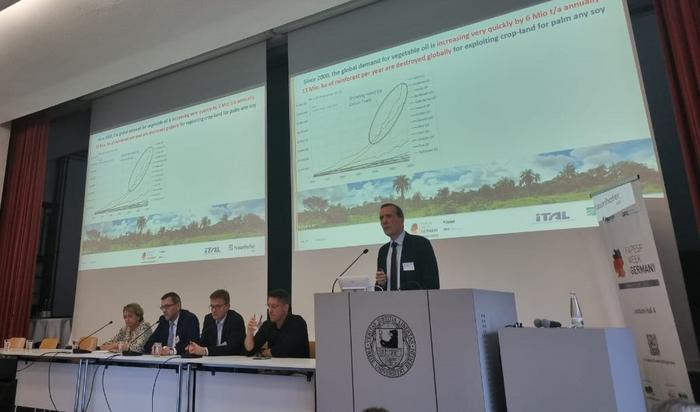Research has increasingly highlighted the potential of fruits and plant extracts as sources of bioactive compounds that may mitigate or avert disease symptoms. A collaborative effort among researchers from Brazil and Germany has emerged, focusing on the identification and understanding of these bioactive compounds and their mechanisms of action via independent yet complementary studies. The significance of these studies was brought to light during a lecture session at FAPESP Week Germany, held at the Free University of Berlin on March 25.
The insights shared by Ulrich Dobrindt, a prominent professor at the University of Munich, elucidate that medicinal plants harbor a diverse array of phytochemicals — natural compounds that can neutralize bacterial infections through various mechanisms, thus enhancing the host’s immune response. This escalating interest in plant extracts as alternatives for preventing and treating urinary tract infections, which rank among the most prevalent infections globally— traditionally managed via antibiotics— signals a pivotal shift in therapeutic approaches.
Despite the well-documented anti-inflammatory, antipyretic, and analgesic properties of these natural products, the scientific community has yet to characterize the active compounds within these plants thoroughly. Notably, flavonoids, alkaloids, and terpenoids are among the studied compounds, though many have not demonstrated antibacterial properties. This gap in knowledge underlines the importance of ongoing research to elucidate the diverse effects of these phytochemicals.
To further scientific understanding, German scientists have created sophisticated infection models aimed at examining how plant extracts influence innate immune responses and the epigenetic regulation of gene expression—biochemical processes that can switch genes on and off. An intriguing aspect of this research involves the analysis of traditional plants recognized for their urological activity as cataloged in the German pharmacopoeia, particularly regarding their influence on bladder cells.
In collaboration with researchers from the Federal University of Minas Gerais (UFMG) in Brazil, significant findings have emerged that certain aqueous plant extracts, specifically derived from species like Solidago gigantea and Equiseti herba, can dramatically hinder the adhesion and survival rates of Escherichia coli in human bladder epithelial cells. These promising results demonstrate a notable decrease in bacterial proliferation in bladder structures, providing crucial insights into potential new treatments for urinary tract infections.
On the Brazilian front, a dedicated team affiliated with the Food Research Center (FoRC), recognized as one of FAPESP’s Research, Innovation and Dissemination Centers, has concentrated its efforts on exploring the technological capacities and biological benefits of non-digestible water-soluble polysaccharides, commonly referred to as bioactive polysaccharides. A key focus of this research has been on pectins, the polysaccharides predominately found in fruits like papaya, passion fruit, and citrus varieties. Their correlation with reduced risks of chronic non-communicable diseases presents an interesting area of exploration.
Nonetheless, challenges exist regarding the extraction processes of such bioactive compounds from fruits that experience rapid ripening. For instance, the quick maturation of papaya can lead to softening pulp and subsequent chemical modifications to the pectin structures, which can impact their biological functionality, notably their effects on gut microbiota modulation. This complex interplay during fruit ripening necessitates thorough investigation to maximize pectin extraction while minimizing structural degradation.
Research efforts undertaken by Brazilian scientists have led to innovative extraction methods designed to derive pectin from the albedo— the white fibrous layer located between the peel and pulp— of oranges and passion fruits, waste by-products normally discarded in juice production. Upon successfully extracting pectin while scientifically altering it within lab settings, the researchers aimed to simplify its molecular structure to enhance its biological efficacy.
This breakthrough in pectin extraction techniques has progressed towards patenting processes aimed at leveraging the health benefits of pectin derived from both fleshy fruits like papaya and chayote. Furthermore, an additional patent concerning the modification of pectin sourced from passion fruit by-products is in the pipeline, reflecting the commitment to advancing this area of research further.
As the team meticulously advanced their extraction and modification methods on a laboratory scale, they endeavored to create a marketable product, envisioning formulations such as a flour rich in modified pectin. Such an innovation could serve as a dietary supplement, offering a new approach to enhancing nutritional intake and possibly health outcomes.
This collaboration has also opened avenues for partnerships with various research entities, culminating in preclinical studies assessing the direct relationship between modified pectins and their biological activity. These rigorous animal studies promise to serve as foundational evidence for future clinical trials assessing the clinical efficacy of modified pectins, particularly in their potential roles as adjuncts in chemotherapy regimens for colon cancer and other therapeutic contexts requiring modulation of intestinal microbiota.
As researchers continue to uncover the untapped potential of bioactive compounds found in fruits and plant extracts, the prospects for innovative treatment modalities expand dramatically. This underscores a broader understanding that the culinary practices carved from nature hold vast medical promise, fundamentally altering the landscape of healthcare solutions available today.
The significance of FAPESP Week Germany extends beyond temporary discussions; it acts as a vibrant catalyst for scientific inquiry, facilitating global collaboration and knowledge exchange aimed at unraveling the complexities of plant-derived compounds. As the synergy between Brazil and Germany exemplifies, multidisciplinary approaches are paramount in addressing public health challenges through innovative research and technology applications that resonate with the needs of contemporary society.
In summary, ongoing research into the bioactive properties of fruits and plant extracts continues to reveal new paradigms in healthcare, emphasizing the intricate relationships between dietary constituents and their potential roles in disease prevention and treatment. As evidenced by these comprehensive studies, the future of food science is unfolding with promising potential that transcends traditional boundaries.
Subject of Research: Bioactive compounds in fruits and plants for health benefits
Article Title: Delving into Nature’s Pharmacy: The Potential of Bioactive Compounds from Fruits and Plants
News Publication Date: March 25, 2025
Web References: FAPESP Week Germany
References: João Paulo Fabi
Image Credits: Elton Alisson/Agência FAPESP
Keywords: Bioactive Compounds, Medicinal Plants, Pectins, Urinary Tract Infections, Phytochemicals, Chronic Diseases, Gut Microbiota, Clinical Trials, Dietary Supplements, Health Benefits.




